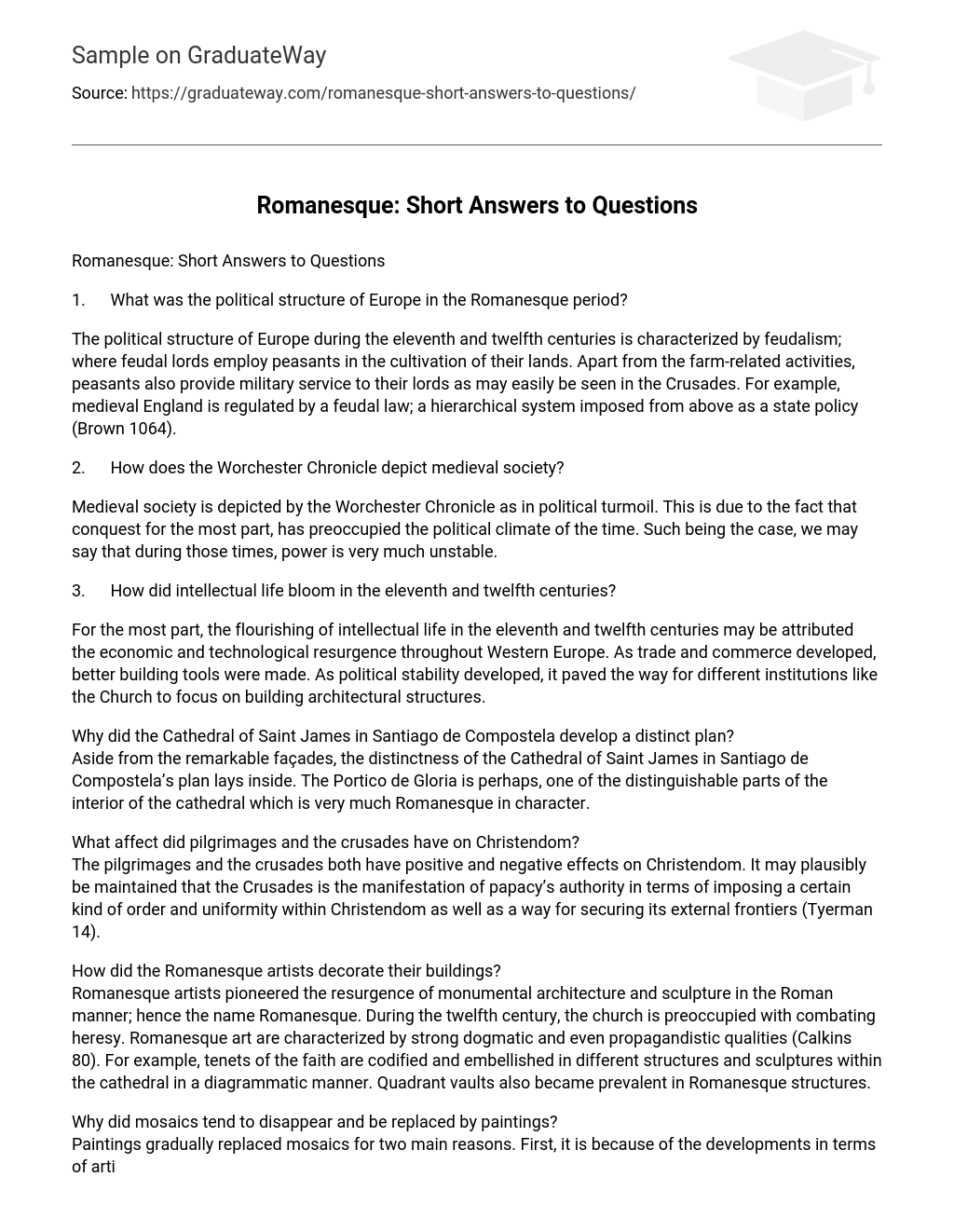1. What was the political structure of Europe in the Romanesque period?
The political structure of Europe during the eleventh and twelfth centuries is characterized by feudalism; where feudal lords employ peasants in the cultivation of their lands. Apart from the farm-related activities, peasants also provide military service to their lords as may easily be seen in the Crusades. For example, medieval England is regulated by a feudal law; a hierarchical system imposed from above as a state policy (Brown 1064).
2. How does the Worchester Chronicle depict medieval society?
Medieval society is depicted by the Worchester Chronicle as in political turmoil. This is due to the fact that conquest for the most part, has preoccupied the political climate of the time. Such being the case, we may say that during those times, power is very much unstable.
3. How did intellectual life bloom in the eleventh and twelfth centuries?
For the most part, the flourishing of intellectual life in the eleventh and twelfth centuries may be attributed the economic and technological resurgence throughout Western Europe. As trade and commerce developed, better building tools were made. As political stability developed, it paved the way for different institutions like the Church to focus on building architectural structures.
Why did the Cathedral of Saint James in Santiago de Compostela develop a distinct plan?
Aside from the remarkable façades, the distinctness of the Cathedral of Saint James in Santiago de Compostela’s plan lays inside. The Portico de Gloria is perhaps, one of the distinguishable parts of the interior of the cathedral which is very much Romanesque in character.
What affect did pilgrimages and the crusades have on Christendom?
The pilgrimages and the crusades both have positive and negative effects on Christendom. It may plausibly be maintained that the Crusades is the manifestation of papacy’s authority in terms of imposing a certain kind of order and uniformity within Christendom as well as a way for securing its external frontiers (Tyerman 14).
How did the Romanesque artists decorate their buildings?
Romanesque artists pioneered the resurgence of monumental architecture and sculpture in the Roman manner; hence the name Romanesque. During the twelfth century, the church is preoccupied with combating heresy. Romanesque art are characterized by strong dogmatic and even propagandistic qualities (Calkins 80). For example, tenets of the faith are codified and embellished in different structures and sculptures within the cathedral in a diagrammatic manner. Quadrant vaults also became prevalent in Romanesque structures.
Why did mosaics tend to disappear and be replaced by paintings?
Paintings gradually replaced mosaics for two main reasons. First, it is because of the developments in terms of artistic theory, particularly schools of thought in painting like the Byzantine school. Second, artists who are by that time, well-commissioned by the church can focus more and devote more time to frescos and murals.
How did the exteriors of Tuscan basilicas differ from the other early Christian basilicas?
Tuscan basilicas built beginning 1018 like the Basilica of San Miniato al Monte’s exteriors differ significantly from early Christian basilicas in terms of the latter’s more decorative arcading. Unlike Romanesque-styled basilicas, the Basilica of San Miniato al Monte’s structural design seems to lack other features where the Romanesque style is renowned; round arches, sturdy piers, groin vaults, large towers and decorative arcading.
What inspired the faithful to travel on pilgrimages?
Pilgrimage provides the faithful an opportunity to express his/her commitment to the faith. By going to the holy land, the faithful believes that he/she establishes a certain kind of tie with the Divine. In other cultures, the faithful looks at pilgrimage as one of the things that he/she must accomplish in order to be fulfilled as a believer and for the soul to attain salvation.
How did the Romanesque builders change the early Christian basilica?
Aside from the structural demands of the time (because they had to think of ways to make the structure solid, secure and highly-resistant to fire), it is also an expression of the church’s stability and triumph.
Works Cited
Brown, Elizabeth. “The Tyranny of a Construct: Feudalism and Historians of Medieval Europe.” The American Historical Review 79 (1974): 1063-1088.
Calkins, Robert. Monuments of Medieval Art. US: Cornell University Press, 1985.
Tyerman, Christopher. Fighting for Christendom: Holy War and the Crusades. Oxford: Oxford University Press, 2004.





